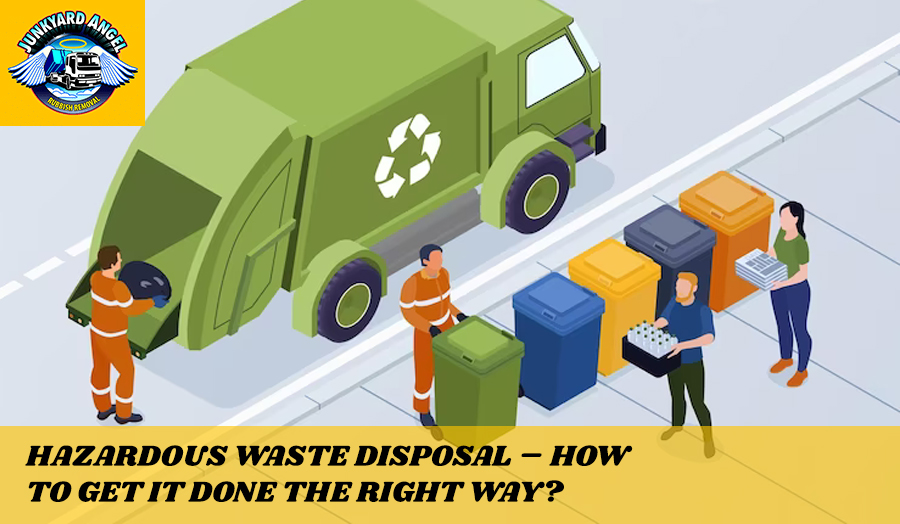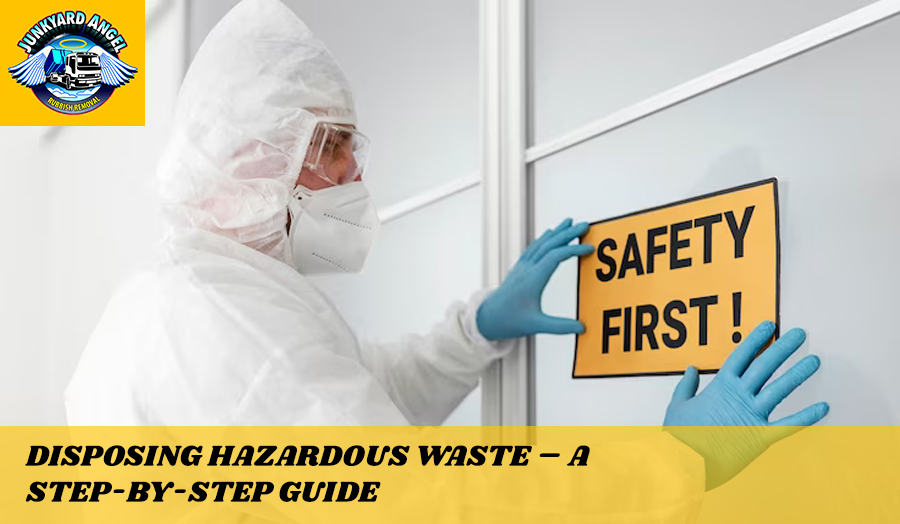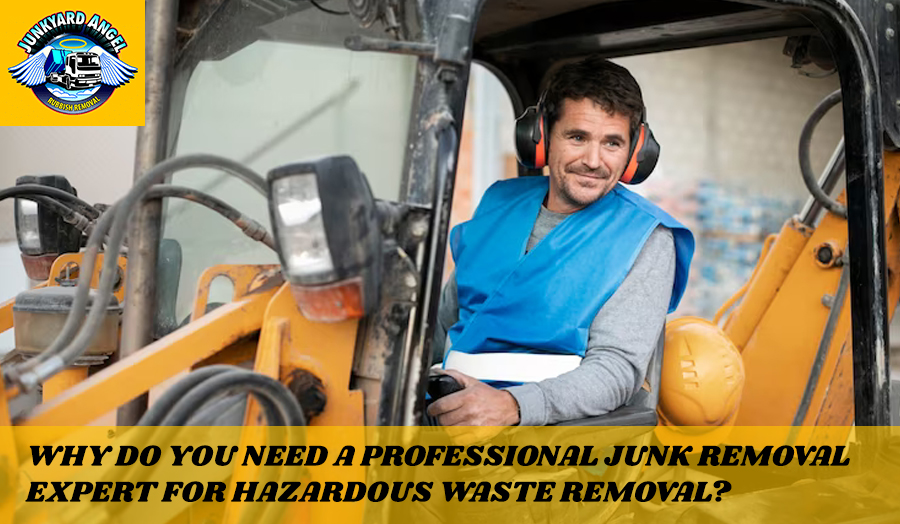
We may be surrounding ourselves with hazardous waste and may not even know about it. Think of old TV, batteries, or chemical-based pest repellents. These are some examples we have in our house but not identified as hazardous waste. It is easy to figure out this type of waste. They are materials that pose a threat to human health or the environment upon their presence or disposal.
Let us examine some common examples of hazardous waste:
1- Home:
- Cleaning chemicals, such as bleach or ammonia
- Pesticides and insecticides
- Electronic waste, such as old computers or TVs
2 – Hospitals:
- Medical waste, including used needles, syringes, and other sharp objects.
- Chemicals used in medical procedures. They include formaldehyde and mercury.
- Radioactive materials. They include materials used in cancer treatments.
3 – Industries:
- Chemical waste, including solvents and acids.
- Hazardous metals, such as lead or cadmium.
- Petroleum-based waste, such as oil or gasoline.
In addition to the above items, there are several other types of hazardous waste that homes and industrial workplace can generate.
Irrespective of the type or origin of the waste, there is a key fact worth remembering. You need to put in the effort into proper handling and disposal of hazardous waste.
If done in the right way, this task will prevent harm to both, people and the environment.
Disposing hazardous waste – A step-by-step guide

The below steps describe the correct approach to dispose of hazardous waste.
1 – Identify Hazardous Waste
You can begin by sifting through different items to identify this particulate of waste. As a general rule of thumb, you can classify any material posing a threat to human health or the environment as hazardous waste. With this step, you can separate the hazardous waste from others.
Examples include batteries and pesticides. They also include medical waste and cleaning chemicals. Once you have identified these, you can properly label any hazardous materials. This will prevent mix-up with other waste.
2 – Put on Personal Protective Equipment (PPE) for safety
When you commence with hazardous waste disposal, keep one important point in mind. Protect yourself with the appropriate PPE. This can include gloves, respirators, goggles, as well as full-body suits. Using PPE can protect you from harmful chemicals and dust from impacting your health and safety.
3 – Use Proper Packaging
Hazardous waste should always be stored in proper packaging. With this step, you can easily avert the likelihood of leaks and spills. Containers should be made of materials that are compatible with the waste they hold.
For example, you should store acid in plastic or glass containers. For storing flammable liquids you may use metal containers. Always remember to seal containers tightly. Lastly, label them clearly to clear references in the future.
4 – Dispose of Hazardous Waste Properly
You should never make the mistake of getting rid of hazardous waste by putting it in regular trash. Instead, it should be taken to a hazardous waste disposal facility. In Vancouver, there are several waste drop-off locations. These include The Vancouver Landfill and Recycling Depot.
But as per the BC Environmental Management Act, you cannot throw hazardous waste as garbage at Vancouver Landfill or Transfer Station. Their disposal needs to be in compliance with
It would help to comply with any specific instructions provided by the disposal facility.
5 – Do not Pour Hazardous Waste Down the Drain
Pouring hazardous waste down the drain is one of the worst things you can do. It can harm the environment significantly. It can also corrode and damage pipes and sewer systems. Even burying them can lead to danger. It may leach into the surface and mix with the surface or groundwater. This will endanger the health and safety of your loved ones.
6 – Know the Laws and Regulations
Hazardous waste disposal is regulated by federal and provincial laws. It is wise to know these regulations. This helps to make sure that you are following the correct procedures for disposing of hazardous waste.
7 – Seek Professional Help
Are you unsure about proper handling of the hazardous waste? Then it is ideal to hire experts for this job. Junk removal companies specialize in hazardous waste removal. They can safely and efficiently dispose of hazardous waste. These companies have the proper equipment and training to handle such types of waste. Therefore, they are the ideal team for environment-friendly hazardous waste disposal.
8 – Recycle Hazardous Waste When Possible
You can look at recycling numerous types of hazardous waste. You can consider batteries, electronic appliances, and light bulbs as household hazardous waste. Recycling these materials can help to bring down the volume of hazardous waste dumped in landfills.
9 – Store Hazardous Waste Properly

Do you need to store hazardous waste for some time before its disposal? Then make sure to store it in a cool and dry place. Remember to keep them out of reach of children and pets.
It will help to double check that the containers are stored upright. You need to store them properly so that there is no risk of tipping over.
Why do you need a professional junk removal expert for hazardous waste removal?

Disposing of hazardous waste can be a strenuous and an extremely risk-prone activity. A DIY approach may tend to do more harm than good.
Hazardous waste can come in many forms. It can be household chemicals or cleaning products. It can also include asbestos, construction debris, and medical waste. It is highly essential to know the safe removal and disposal process. This knowledge will prevent harm to yourself and those around you.
This is where experts in junk removal in Vancouver come in handy.
Their crew has years of experience dealing with different types of waste and their effective disposal. Hence, it makes complete sense to hire their services for a thorough job.
Let us look at some key reasons why hiring professionals is much better than taking the DIY route.
1 – Safety
Professional junk removal companies have extensive domain knowledge. They are trained to do a meticulous job. The tools and equipment they carry help them safely handle and dispose of hazardous waste. This way, they avoid any risks of injury to themselves or others.
2 – Compliance
Hazardous waste disposal is regulated by federal, state, and local laws. If you fail to comply with their norms, then you may be slapped with hefty fines. Rely on a junk removal expert to avoid this mistake. They will help get rid of hazardous waste in compliance with the applicable regulations in Vancouver.
3 – Cost-effectiveness
Initially, it may seem cheaper to dispose of hazardous waste on your own. But when you start with it, you will realize the folly of the decision. Improper or insufficient disposal methods can lead to costly fines and be potentially life-threatening. Go for a professional junk disposal crew instead. They can actually save you money in the long run by avoiding these costs and risks.
4 – Convenience
It is stressful as well as time-consuming to identify and get rid of hazardous waste. This problem is exacerbated if you are unfamiliar with the proper waste disposal procedures. This is why it makes sense to hire experts who have the knowledge and experience in junk disposal.
5 – Liability
Are you thinking of getting rid of hazardous waste? Then make sure it is as per municipal laws. Else, the local municipal authority may hold you liable for damages.
Why pile up additional stress in your life when you have an easier alternative in front of you?
You can go for a competent junk removal expert. Their skills will come in handy in protecting you from this type of liability. They enable this advantage by doing prompt and proper removal of hazardous waste, as per the legal provisions.
To sum it up
Remember, when it comes to hazardous waste, it is always better to be safe than sorry. So, make sure to connect with a reliable and proficient expert in junk removal in Vancouver. They have the expertise and equipment to safely remove and dispose of it.
Connect with us to know more about the proper hazardous waste disposal approach.
